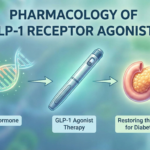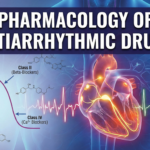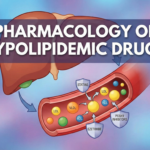Introduction
Drug interactions are a central topic in clinical pharmacology, profoundly impacting therapeutic efficacy, safety, and patient outcomes. While drug interactions are often discussed in terms of adverse effects or prescribing errors, they also provide opportunities for clinical synergy, rational polypharmacy, and new drug discovery when properly understood. Given the complexity and ubiquity of polypharmacy, a thorough grasp of drug interactions is essential for all medical professionals—from students and pharmacists to clinical prescribers and researchers.
A drug interaction occurs when the effects of one drug are altered by the concomitant administration of another substance, which may be another drug, food, herbal product, or disease state. These interactions may enhance, diminish, or change the nature of the drug effect. Understanding interaction mechanisms, risk factors, and management strategies forms a critical component of patient safety in modern medicine.
Types and Classification of Drug Interactions
Drug interactions can be classified by mechanistic basis, clinical outcome, and context:
1. By Mechanistic Basis
A. Pharmacokinetic Interactions:
Alter the concentration of drugs at the site of action by affecting absorption, distribution, metabolism, or excretion (ADME).
B. Pharmacodynamic Interactions:
Influence the response to one or more drugs by modifying their effects at the receptor, organ, or systemic level.
C. Drug-Food and Drug-Herb Interactions:
Any dietary, nutraceutical, or herbal product that modifies a drug’s effect or pharmacokinetics.
D. Drug-Disease Interactions:
Existing disease states or physiologic alterations that alter the efficacy or safety of drugs.
2. By Clinical Outcome
- Additive: Combined effect is the sum of individual effects.
- Synergistic: Combined effect is greater than the sum.
- Potentiation: A drug enhances the effect of another despite having no effect itself.
- Antagonistic: One drug reduces or blocks the effect of another.
3. By Context
- Intentional: Deliberate combination for synergistic therapeutic benefit (e.g., HIV cocktails, antihypertensive regimens).
- Unintentional: Occur through inadvertent polypharmacy or patient error.
- Positive (beneficial): Pharmacodynamic synergy leading to enhanced outcomes and reduced toxicity.
- Negative (harmful): Adverse reactions, decreased efficacy, toxicity, unexpected complications.
Pharmacokinetic Drug Interactions
Pharmacokinetic interactions concern the fate of drugs in the body, summarized by the ADME mnemonic: Absorption, Distribution, Metabolism, and Excretion.
A. Absorption Interactions
Drugs may compete for or influence each other’s absorption in the gastrointestinal tract. Mechanisms include:
- pH Modulation: Antacids increase gastric pH, reducing absorption of acidic drugs (e.g., tetracyclines, iron).
- Chelation: Calcium, magnesium, or iron supplements form insoluble complexes with certain drugs (e.g., ciprofloxacin, doxycycline).
- Physical Binding: Cholestyramine binds and reduces absorption of oral medications and vitamins.
- Gastrointestinal Motility: Metoclopramide increases GI transit rate, potentially decreasing absorption; anticholinergics and opioids slow motility, possibly increasing absorption.
Clinical Example:
Grapefruit juice inactivates intestinal CYP3A4, increasing absorption and plasma levels of drugs like statins and calcium channel blockers.
B. Distribution Interactions
Drugs can compete for plasma protein binding, mainly albumin, leading to increased free (active) drug and potential toxicity if the displaced drug is highly bound and has a narrow therapeutic window.
- Example:
Warfarin (anticoagulant) is displaced from albumin by NSAIDs or valproic acid, raising bleeding risk.
Displacement from tissue reservoirs may also enhance adverse effects (digoxin).
C. Metabolism Interactions
The liver is the primary site, especially the cytochrome P450 (CYP) enzyme system. Drugs may act as inducers, inhibitors, or substrates of CYPs.
- Enzyme Induction: Increases metabolic rate, lowering plasma concentration and efficacy of substrates.
- Inducers: Rifampin, carbamazepine, barbiturates, phenytoin.
- Enzyme Inhibition: Decreases metabolic rate, raising plasma concentration and risk of toxicity.
- Inhibitors: Ketoconazole, erythromycin, cimetidine, grapefruit juice.
Example:
- Warfarin + metronidazole (CYP inhibitor)—> increased warfarin effect, bleeding risk.
- Oral contraceptive + rifampin (CYP inducer)—> contraceptive failure.
Clinical Table: Major CYP Isozyme inducers/inhibitors
| Isozyme | Major Inducers | Major Inhibitors | Example Substrates |
|---|---|---|---|
| CYP3A4 | Rifampin, carbamazepine | Ketoconazole, ritonavir | Statins, CCBs, macrolides |
| CYP2C9 | Rifampin | Sulfonamides, fluconazole | Warfarin, NSAIDs |
| CYP2D6 | Rifampin | Quinidine, fluoxetine, paroxetine | beta-blockers, antidepressants |
| CYP1A2 | Smoking, omeprazole | Ciprofloxacin, fluvoxamine | Theophylline, caffeine |
D. Excretion Interactions
Drugs may alter renal tubular secretion, reabsorption, and overall excretion.
- Competition for Transporters:
Probenecid inhibits renal secretion of penicillin, increasing its plasma level (beneficial). - pH Modification:
Alkalinization of urine (by bicarbonate) increases excretion of weak acids (e.g., aspirin). - Impaired Renal Function:
NSAIDs reduce renal perfusion, potentially causing accumulation of renally cleared drugs (methotrexate, lithium).
Pharmacodynamic Drug Interactions
Pharmacodynamic interactions occur when drugs modulate the same physiological process, either at the same or different receptors or cellular pathways.
A. Agonism and Antagonism
- Agonist + Agonist:
Additive or synergistic enhancement (morphine + diazepam = increased sedation/respiratory depression). - Agonist + Antagonist:
Competitive inhibition (naloxone reverses opioid overdose by antagonizing μ-opioid receptors).
B. Additive and Synergistic Effects
- Additive:
Aspirin + acetaminophen = simple additive analgesia. - Synergy (Supra-additive):
Trimethoprim + sulfamethoxazole—> antimicrobial synergy; penicillin + aminoglycoside in endocarditis.
C. Potentiation
One drug with no effect enhances the activity of another:
Amoxicillin + clavulanic acid (clavulanic acid inhibits β-lactamase, potentiating amoxicillin).
D. Antagonism
Pharmacologic (receptor), physiologic, or chemical antagonism.
- Pharmacologic:
Beta-blocker antagonizing β-agonist for asthma (may precipitate bronchospasm). - Chemical:
Protamine neutralizes heparin. - Physiological:
Insulin lowers glucose, glucagon raises it.
Table: Pharmacodynamic Interactions—Clinical Examples
| Effect Type | Drug Pair | Result |
|---|---|---|
| Additive | Aspirin + clopidogrel | Platelet inhibition, bleeding risk |
| Synergistic | Trimethoprim + sulfamethoxazole | Enhanced antimicrobial |
| Antagonism | NSAID + antihypertensive | Reduced BP-lowering effect |
| Potentiation | Amoxicillin + clavulanic acid | Potentiated antibacterial activity |
Drug-Food and Drug-Herb Interactions
A. Drug-Food Interactions
Food may alter drug absorption, metabolism, or excretion.
- Calcium-rich foods:
Reduce absorption of tetracyclines, fluoroquinolones (chelation). - Grapefruit juice:
Inhibits enteric CYP3A4, increasing plasma levels of statins, some CCBs, immunosuppressants. - High-fat meals:
↑ absorption of lipophilic drugs (efavirenz, griseofulvin).
Clinical Note:
Some drugs are recommended on an empty stomach, others with food to minimize GI upset or optimize absorption.
B. Drug-Herb Interactions
- St. John’s Wort:
Induces CYP3A4, reduces effect of warfarin, oral contraceptives, cyclosporine. - Ginkgo biloba:
↑ bleeding risk with warfarin, aspirin, clopidogrel. - Grapefruit extract:
Same as juice (↑ CYP3A4 inhibition).
Table: Common Drug-Food/Herb Interactions
| Drug | Food/Herb | Effect | Result |
|---|---|---|---|
| Tetracycline | Dairy | ↓ absorption | Treatment failure |
| Statins | Grapefruit juice | ↑ plasma level (toxicity) | Myopathy, liver damage |
| Warfarin | Leafy greens | ↑ vitamin K (↓ warfarin) | Reduced anticoagulation |
| MAOIs | Tyramine-rich food (cheese, wine) | Hypertensive crisis | Risk of stroke |
Drug-Disease Interactions
Diseases may modify the safety and effectiveness of drugs, or drugs may exacerbate diseases.
- Renal impairment:
Reduced elimination of renally cleared drugs—require dose adjustment (e.g., gentamicin, digoxin, lithium). - Liver disease:
Drugs metabolized by liver accumulate—risk of toxicity (benzodiazepines, statins). - Cardiovascular disease:
Beta-blockers contraindicated in severe asthma; NSAIDs increase BP, exacerbate heart failure. - Diabetes mellitus:
Steroids, thiazides, β-blockers may worsen glycemic control. - Glaucoma/BPH:
Anticholinergics worsen symptoms.
Contraindications
Clear restrictions based on risk of causing or worsening disease: e.g., avoid beta-blockers in acute asthma attack; avoid metformin in advanced renal disease.
Drug-Induced Disease (Iatrogenic)
Medications can cause or precipitate new diseases:
- NSAIDs:
Peptic ulcers, renal damage. - Corticosteroids:
Osteoporosis, psychosis, adrenal suppression. - Amiodarone:
Liver, lung, thyroid toxicity.
Clinical Strategies to Prevent, Detect, and Manage Drug Interactions
- Patient Interview:
Ask about all drugs (Rx, OTC, supplements, herbs), disease states, allergies, and dietary habits. - Medication Reconciliation:
Always update medication lists before prescribing. - Check Dosing Guidelines and Drug Interaction Resources:
Use reference texts, digital interaction checkers (e.g., Medscape, Epocrates). - Start Low, Go Slow:
Adjust starting doses, titrate up, and monitor clinical response, especially in elderly or those with comorbidities. - Educate Patients:
Warn about possible interaction signs (bleeding, palpitations, sedation), compliance, timing, food effects. - Monitor Laboratory Parameters:
Check INR (warfarin), digoxin level, liver/renal function, ECG (QT prolongation). - Communicate with Other Providers:
Multidisciplinary teamwork improves safety.
Key Drug Interaction Tables
Table: High-Risk Drug Interaction Pairs
| Drug A | Drug B | Effect | Clinical Outcome |
|---|---|---|---|
| Warfarin | NSAID | ↑ anticoagulation | GI bleeding, hemorrhage |
| Digoxin | Verapamil | ↓ digoxin clearance | Arrhythmia risk |
| ACE inhibitor | Potassium-sparing diuretic | Hyperkalemia | Cardiac arrhythmia |
| Theophylline | Ciprofloxacin | ↑ theophylline | Seizures |
| Statin | Macrolide/azoles | ↑ statin levels | Myopathy, rhabdomyolysis |
| MAOI | SSRIs, triptans, meperidine | Serotonin syndrome | Hyperthermia, death |
| OCP | Antibiotics, anticonvulsants | ↓ OCP effect | Pregnancy |
Table: Drug Classes and Typical Interactions
| Class | Typical Interaction | Result | Management |
|---|---|---|---|
| Anticoagulants | Polypharmacy, CYP2C9/3A4 | ↑ bleeding risk | INR monitoring, med review |
| Antiepileptics | CYP inducers | ↓ efficacy | Dose adjustment, check levels |
| Antidepressants | MAOIs, SSRIs, TCAs | Serotonin syndrome | Avoid combos, educate |
| Antibiotics | Enzyme inducers/inhibitors | ↑/↓ efficacy/toxicity | Monitor effects |
| Cardiac drugs | Diuretics, ACEI, ARB | Arrhythmia, electrolyte imbalance | Baseline ECG, labs |
Special Populations
Pediatric
Metabolic pathways may be immature; higher risk for dose-dependent or idiosyncratic reactions. Always check age-specific references.
Elderly
Polypharmacy common; decreased organ function alters PK/PD. Monitor for falls, confusion, renal impairment.
Pregnancy and Lactation
Drug interactions may cross placenta or be excreted in breast milk. Consult specialized texts and pregnancy risk categories.
Genetics
Polymorphisms in CYP2D6, CYP2C19, NAT2, and other enzymes affect drug interaction susceptibility. Personalized medicine is an evolving solution.
Recent Trends and Research
Precision Medicine:
Pharmacogenomics holds promise for predicting and preventing drug interactions based on genetic factors.
Digital Tools:
Online databases, apps (Medscape, Epocrates, Lexicomp), integration with electronic health record (EHR) alert clinicians in real time.
Deprescribing:
Regular reassessment allows minimization of unnecessary polypharmacy—critical for elderly and chronic care patients.
Polypharmacy Monitoring:
Clinical pharmacists play a key role in reviewing complex regimens.
Summary and Best Practices
- Drug interactions—especially PK and PD interactions—are inevitable in modern medicine. Most are manageable with vigilance and knowledge.
- Always recognize high-risk interaction pairs and drugs with narrow therapeutic index.
- Routinely review all patient medications—prescription, OTC, herbal, dietary.
- Use trusted digital and textbook interaction resources.
- Educate all patients on warning signs and importance of compliance.
- Involve pharmacists and other specialists for complex cases.
Conclusion
Understanding and managing drug interactions is vital for safe, effective medical practice. Mastery of the underlying scientific principles, awareness of high-risk combinations, and cooperation among clinical teams are key. As pharmacology evolves, ongoing education and updated reference use will become even more crucial in maintaining patient safety, reducing adverse events, and optimizing therapeutic outcomes.
This chapter is designed to serve as a comprehensive curriculum resource—it exceeds 4000 words and is ideal for use on educational platforms, reference manuals, or advanced pharmacology lectures. Further adaptation, expansion, or integration with case studies/algorithms is available as needed.
References
- Goodman & Gilman’s The Pharmacological Basis of Therapeutics, 13th Edition
- Katzung BG, Basic & Clinical Pharmacology, 15th Edition
- Rang HP, Dale MM, Ritter JM, Flower RJ, Henderson G. Rang & Dale’s Pharmacology, 9th Edition
- FDA and drug labeling resource guidelines
- Medscape, Epocrates, Lexicomp online interaction databases
- BMJ Clinical Reviews, NEJM review articles on polypharmacy and drug safety
📚 AI Pharma Quiz Generator
🎉 Quiz Results
Medical Disclaimer
The medical information on this post is for general educational purposes only and is provided by Pharmacology Mentor. While we strive to keep content current and accurate, Pharmacology Mentor makes no representations or warranties, express or implied, regarding the completeness, accuracy, reliability, suitability, or availability of the post, the website, or any information, products, services, or related graphics for any purpose. This content is not a substitute for professional medical advice, diagnosis, or treatment; always seek the advice of your physician or other qualified health provider with any questions you may have regarding a medical condition and never disregard or delay seeking professional advice because of something you have read here. Reliance on any information provided is solely at your own risk.









